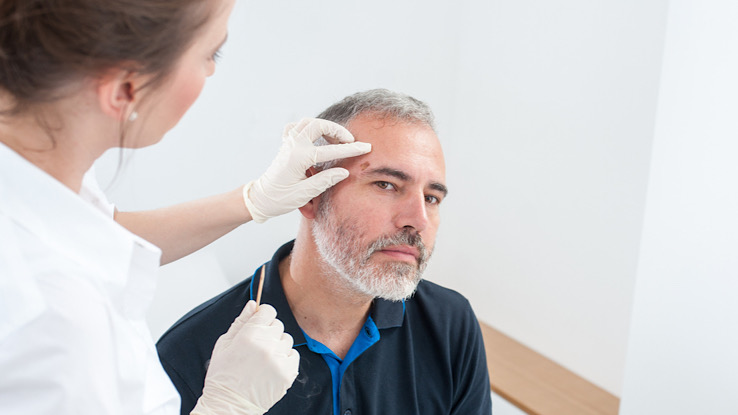
Keratosis refers to any skin disorder that involves the abnormal growth of a protein in the skin called keratin. Changes in keratin levels lead to visible growths on the skin that vary in appearance. There are several types of keratosis, which range in their severity of symptoms and treatment recommendations. The three most common types of keratosis are actinic keratosis, seborrheic keratosis, and keratosis pilaris. Read on to find out more about the unique qualities of each type.
Actinic Keratosis
Actinic keratosis (also known as solar keratosis) is the progressive appearance of a rough and scaly patch of skin that develops from years of exposure to UV light from the sun or tanning beds. It is most common on areas of the skin that are frequently exposed to the sun, such as the face, ears, back of the hands, forearms, scalp, or neck. Symptoms of actinic keratosis can include:
- A dry or rough patch of skin (usually less than one inch in diameter)
- A flat to slightly raised patch of skin
- A wart-like patch on your skin
- A cluster of pimples
- Discoloration. Affected skin color can range from pink to red to brown
- Itching, tenderness, burning or bleeding in the affected area
- Lack of healing over time
Actinic keratosis can be precancerous. In about 1 in 10 cases, it can lead to squamous cell carcinoma, which is not life-threatening as long as you find it and treat it early. If actinic keratosis is suspected, it is important to see a doctor or dermatologist right away. They can diagnose skin growths by a physical exam, or they may order a biopsy to examine the skin cells more closely. If the growth is precancerous, you can treat or remove the lesion in numerous ways. These include:
- Topical medications
- Cryotherapy: sometimes known as cold therapy. It uses extreme cold to destroy tissue.
- Curettage: shaving the skin’s surfaces
- Laser therapy
- Chemical peels
Protecting skin from the sun is the best way to prevent the development of actinic keratosis and the risk of skin cancer. Remember to use sunscreen regularly and keep vulnerable areas of the skin covered by clothing or hats.
Seborrheic Keratosis
Seborrheic keratosis leads to skin growths that are generally harmless; they are not cancerous and not contagious. The exact cause of these skin growths is not known. They are most common on the upper body (chest, back, head, and neck). The following characteristics can identify them:
- Discoloration. Affected skin color may appear light tan, brown, or black
- A growth that is round or oval shape
- A flat or slightly elevated growth with a waxy, scaly, or wart-like surface
- Itchiness in the affected area
In most cases, a doctor can diagnose seborrheic keratosis by visually examining the affected area. Sometimes a seborrheic keratosis may resemble a lesion caused by skin cancer. So, to rule out skin cancer, your doctor may recommend removing the growth to examine the lesion under a microscope. In most cases, seborrheic keratosis is non-cancerous and requires no medical intervention. But, if the growths are bothersome, you may choose to have the seborrheic keratosis growths removed. Similar to actinic keratosis, you can remove the patch or lesion with:
- Cryotherapy
- Curettage
- Laser therapy
- Chemical peels
Keratosis Pilaris
Keratosis pilaris occurs when pores in the skin become clogged with dead skin cells that contain keratin. This leads to visible bumps most commonly found on the upper arms, thighs, and buttocks. Keratosis pilaris can occur at any age and typically lasts for many years. This type of keratosis does not cause any pain and is usually non-cancerous. It also does not have any long-term health implications. Symptoms of keratosis pilaris may include:
- Small discolored or acne-like bumps
- Red and inflamed areas of the skin
- Dry or rough patches of skin
- Itchiness
- Improvement in the summertime and worsening in colder months
Keratosis pilaris tends to run in families. It is more common in individuals who also have asthma, eczema, seasonal allergies, or are taking certain medications to treat skin melanoma. A doctor can diagnose this skin condition after talking to you about your medical history during a routine physical exam.
If the symptoms of keratosis pilaris become bothersome, there are ways to help prevent the buildup of skin cells that block the pores. Gentle exfoliation and moisturizing the skin regularly are available home remedies. If symptoms do not improve, talk with your doctor about treatment options, including topical medications or laser therapy.
Medical content reviewed by Madeline Hubbard, RN, BSN
Resource Links:
- “Keratosis Pilaris: Who Gets and Causes” via American Academy of Dermatology Association
- “Keratosis pilaris” via NHS
- “Actinic Keratosis: Diagnosis and Treatment” via American Academy of Dermatology Association
- “Actinic Keratosis” via Mayo Clinic
- “Seborrheic Keratosis” via Mayo Clinic





